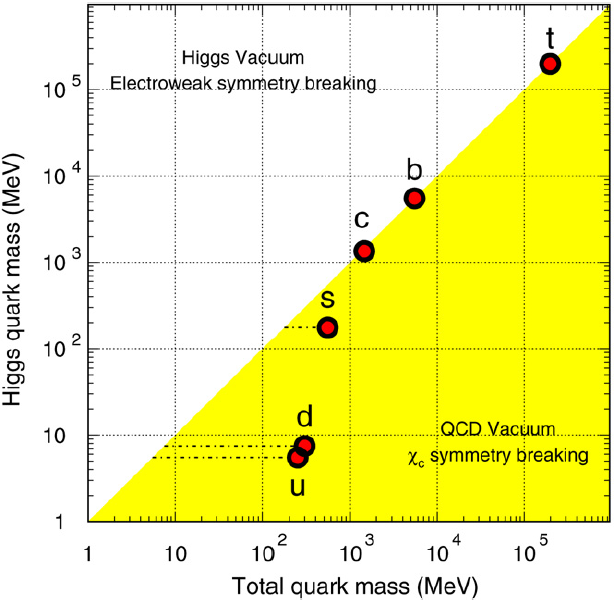Heavy Flavor
 Depending on the energy scale, there are two mechanisms that generate quark masses with different degrees of importance: current quark masses are generated by the electroweak symmetry breaking mechanism (Higgs mass) and spontaneous chiral symmetry breaking leads to the constituent quark masses in QCD (QCD mass). The QCD interaction strongly affects the light quarks (u, d, s) while the heavy quark masses (c, b, t) are mainly determined by the Higgs mechanism. In high-energy nuclear collisions at RHIC, heavy quarks are produced through gluon fusion and qq¯ annihilation. Heavy quark production is also sensitive to the parton distribution function. Unlike the light quarks, heavy quark masses are not modified by the surrounding QCD medium (or the excitations of the QCD medium) and the value of their masses is much higher than the initial excitation of the system. It is these differences between light and heavy quarks in a medium that make heavy quarks an ideal probe to study the properties of the hot and dense medium created in high-energy nuclear collisions.
Depending on the energy scale, there are two mechanisms that generate quark masses with different degrees of importance: current quark masses are generated by the electroweak symmetry breaking mechanism (Higgs mass) and spontaneous chiral symmetry breaking leads to the constituent quark masses in QCD (QCD mass). The QCD interaction strongly affects the light quarks (u, d, s) while the heavy quark masses (c, b, t) are mainly determined by the Higgs mechanism. In high-energy nuclear collisions at RHIC, heavy quarks are produced through gluon fusion and qq¯ annihilation. Heavy quark production is also sensitive to the parton distribution function. Unlike the light quarks, heavy quark masses are not modified by the surrounding QCD medium (or the excitations of the QCD medium) and the value of their masses is much higher than the initial excitation of the system. It is these differences between light and heavy quarks in a medium that make heavy quarks an ideal probe to study the properties of the hot and dense medium created in high-energy nuclear collisions.
Heavy flavor analyses at STAR can be separated into quarkonia, open heavy flavor and heavy flavor leptons.
Comments on Low pT J/psi dAu paper
Comments on the paper and on the technical note are included in the pdf files below.
Response to PRD referee comments on Upsilon Paper
First Round of Referee Responses
Click here for second round.
e-h correlation in Run9 500 GeV
Updated on Sun, 2010-03-28 14:17 by xwq1985. Originally created by dongx on 2010-03-10 18:50.Reference
Speaker : Wei Li ( SINAP/UCLA )
Talk time : 16:15, Duration : 00:30
Embedding Discussion
Updated on Tue, 2010-01-12 15:10 by xwq1985. Originally created by dongx on 2010-01-06 19:33.Reference
Speaker : all
Talk time : 14:30, Duration : 01:30
NPE analysis in run 2008 d+Au
Updated on Wed, 2009-10-07 12:47 by xwq1985. Originally created by dongx on 2009-09-25 13:24.Reference
Speaker : Wenqin Xu ( UCLA )
Talk time : 16:15, Duration : 00:30
Estimating Drell-Yan contribution from NLO calculation.
Code to run Pythia and produce b-bbar -> e+ e- events
// main00.cc
// Modified from the main01.cc
// which is a part of the PYTHIA event generator.
// Copyright (C) 2008 Torbjorn Sjostrand.
Using Pythia 8 to get b-bbar -> e+e-
We used Pythia 8 to produce b-bbar events. First we used the default Pythia 8.
Summary
Updated on Wed, 2008-05-21 13:59. Originally created by calderon on 2008-05-16 16:37.Speaker : Manuel Calderon
Talk time : 17:00, Duration : 00:20
Hard Probes 2008 Discussion
Updated on Fri, 2008-05-16 16:35. Originally created by calderon on 2008-05-16 16:35.Speaker : All
Talk time : 16:15, Duration : 00:45
J/psi in 200 GeV Cu+Cu
Updated on Sat, 2008-05-17 14:01 by kikola. Originally created by calderon on 2008-05-16 16:32.Speaker : Daniel Kikola
Talk time : 15:30, Duration : 00:45
Upsilons in Run7 200 GeV Au+Au
Updated on Sun, 2008-05-18 11:27 by debasish. Originally created by calderon on 2008-05-16 16:30.Speaker : Debasish Das
Talk time : 14:45, Duration : 00:45
2007 AuAu Upsilon background and Preshower
Updated on Sat, 2008-05-17 19:20 by rfc. Originally created by calderon on 2008-05-16 16:29.LInk to my webpage about Upsilon and Preshower can be found here
Email:
Speaker : Rory Clark
Talk time : 14:00, Duration : 00:45
Lunch
Updated on Fri, 2008-05-16 16:24. Originally created by calderon on 2008-05-16 16:24.Talk time : 12:00, Duration : 02:00
e-h Correlations in CuCu 200GeV
Updated on Sat, 2008-05-17 10:03 by bielcik. Originally created by calderon on 2008-05-16 16:22.Speaker : Jaroslav Bielcik
Talk time : 11:15, Duration : 00:45
Discussion on long paper on e-h, e-D, D* in jets
Updated on Fri, 2008-05-16 16:20. Originally created by calderon on 2008-05-16 16:20.Talk time : 10:30, Duration : 00:45
Non-photonic electron-D0 Correlations in 200 GeV p+p
Updated on Sat, 2008-05-17 13:23 by amischke. Originally created by calderon on 2008-05-16 16:18.Speaker : Andre Mischke ( Utrecht University )
Talk time : 09:45, Duration : 00:45
